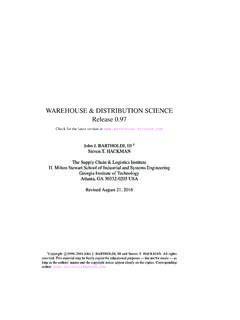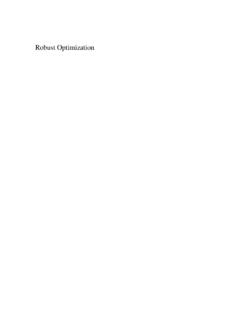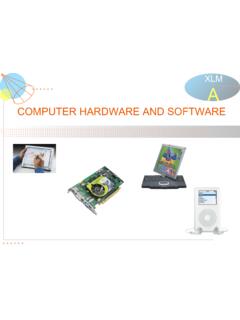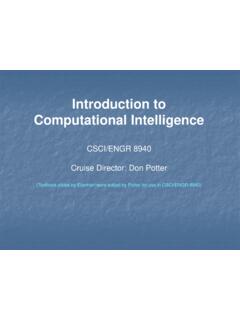Transcription of Chapter 11. Facilities Design Introduction
1 Logistics Systems DesignChapter 11. Facilities Design Introduction 199 Chapter 11. Facilities Facilities Design DefinitionFacilities Design is the planning and Design of the physical environment of anactivity to best support the execution of this other words, Facilities Design attempts to organize the tangible fixed assets of anactivity in such way as to provide maximal support for the achievement of theactivity's objectives at the present time and in the future at the lowest possible activity can take many different forms, manufacturing (plant layout), healthcare (hospital layout), transportation (airport layout) and services (bank layout).Objectives of a Good Facilities Design1. The Facilities Design should first and foremost enable and support theactivity. This implies that it must enable the throughput requirements,storage requirements, and flow time A secondary characteristic is that the activity can be executed atminimal cost for the given set of throughput, storage, response timerequirements.
2 Conflicting objectives at this level are increasing serverutilization and decreasing the material handling cost, which consists ofstorage and transportation Finally, a good facility is flexible and robust enough so that it canaccommodate server and material handling device breakdowns and thatit can be adapted to a different product Associated with a Facilities DesignA Facilities Design has associated fixed and variable costs. Fixed costs are incurred ifan activity is executed at all. Examples are the server acquisition costs for theproduction function and the device acquisition costs and costs for buffer, inventorystorage, aisles and transportation space for the material handling costs depend on the intensity of the executed activity. Examples are the unitproduction costs for the production function and the unit transportation costs for thematerial handling Chapter 11.
3 Facilities Design IntroductionLogistics Systems DesignCharacteristics of a Facilities Design ProjectFacilities Design is a typical engineering Design project and as such exhibits the maincharacteristics of any (large) engineering Design Facilities Design is a complex problem. The problem is ill defined, theobjectives and constraints are fuzzy . Different people have differentdefinitions and objectives of the project. Some constraints areimplicitly assumed. Hence, there does not exist an optimalmathematical solution as in linear programming. Many, very differentsolutions can be equally Facilities Design is an interdisciplinary team effort. No engineer cando all the work or has all the expertise. Many different groups will beusing the facility and have different requirements for the between all the user groups and the Design team isessential for the later acceptance of the Activities and their supporting Facilities change constantly over timeand the Facilities Design project will be redefined in a spatial and temporal master plan is essential for futureefficient use of the The mathematical models for such a complex, fuzzy , and dynamicdesign problem are very hard to formulate and Most computer algorithms require a clear and precise statement of theproblem, objectives, and constraints.
4 The Facilities Design problemdoes not any of these, so there has been very limited success with theapplication of Computer Aided Layout (CAL) As a consequence, the Design engineer is still very important in thefacilities Design Main Facilities Design PrincipleOptimize & Minimize the Material FlowOne of the major objectives of Facilities Design is to arrange the processing centers insuch a way that the cost of material handling operations between the centers isminimized. A good facility Design will always be characterized by a simple andintuitive material flow. In most instances, Facilities Design tries to minimize thedistances traveled between processing Steps in the Facility Design ProcessFacilities Design Process StepsThe facility Design process follows the same steps as any engineering Design Systems DesignChapter 11.
5 Facilities Design Introduction 201 Most Facilities Design projects identify the following elements during the first twophases of the engineering Design process:1. Identify the major material handling flows in the project. This material flow can be many different things depending on the facilitiesdesign application. In a hospital, patients, medical personnel, drugs,and medical supplies are all important material flows. In an airport,passengers (arriving and departing), crew, planes, and luggage are allimportant material flows. In a bank customer, personnel, documents,and money are examples of important material flows. Finally, inmanufacturing, parts, personnel, and tools can be examples of the majormaterial handling For each of the material handling flows in step 1, identify the majorprocessing steps.
6 Again this includes a wide variety of task dependingon the application. Examples are customer dining in a restaurant,luggage carousel in an airport, drug storage in the pharmacy of ahospital, The processing steps are executed in activity centers Construct a graph with a column for each of the material handling flowsand a row for each of the activity centers. For each of the materialhandling flow a line is drawn between the activity centers to indicate theorder in which the centers are visited. An example of such a graph is amultiproduct process Given the material handling flows and the activity centers determinethe affinities between the activity centers in a common unit. If onlymaterial handling flows are present, then this is a relatively easy material handling load such as a pallet of fork lift truck trip mightbe the common material handling unit.
7 If other affinities are alsopresent, then their size must be carefully determined to be consistentwith the material flow units. Examples of positive affinities are thedesirability of having windows in offices and cafeterias, which implies alocation on the perimeter of the layout. Examples of negative affinitiesare welding (which produces sparks) and painting (which producescombustible vapors) departments, vibration pollution between astamping and a measuring department and noise pollution between asawing and an office department. Once a common handling unit hasbeen defined, the flows in the above graph can now be quantified. Allmaterial handling flows and other affinities are then summarized in arelationship matrix also called a from-to matrix, which has as elementsthe sum of the affinities between two departments for all major materialhandling Given the material handling flows that need to be processed in each ofthe activity centers, compute the number of individual servers requiredin each activity center.
8 Finally, based on the number of servers and therequired area for each server and possible space for waiting area for theserver, compute the required area for each activity Chapter 11. Facilities Design IntroductionLogistics Systems Characteristics of a Good Facilities DesignGrowing Cost of ModificationsThe cost of making changes to a Design project grows exponentially over time. Thiscan best be illustrated by Figure $Planning Designing Building Installing CommissioningFigure Exponential Cost of Design ChangesDesign for IntegrationHence the current Facilities Design project should be integrated with the overallspatial and temporal master plan of the organization. Future expansions,contractions, and relocations of the material flow should be anticipated and for FlexibilityTo adapt to the constantly changing environment, business systems themselves mustalso change.
9 The changes in product, production techniques and equipment haveaccelerated in the recent years. To minimize the long-term costs the Facilities shouldaccommodate this change. Hence Facilities should be designed with flexibility andchange in mind. One might call such easily reconfigurable Facilities agile Facilities . Designing for future flexibility must be traded off with designing for maximalefficiency for the current Product, Process, Schedule, and Facilities DesignProduct DesignProduct Design involves both the determination of which products are to be producedand the detailed Design of individual products. It answers the basic question WHAT will be Systems DesignChapter 11. Facilities Design Introduction 203 Process DesignProcess Design involves the determination of required type and sequence ofproduction steps to manufacture a product.
10 This includes the classical "make-or-buy"decision. It answers the basic question HOW will be DesignSchedule Design involves the determination of which quantities at what times will beproduced. Schedule Design philosophies such as "Material Requirements Planning"(MRP) and "Just In Time" (JIT) can help answer these questions. It answers thebasic question HOW MUCH and WHEN will be DesignFacilities Design involves the determination of the Design of the physicalenvironment of an activity. It answers the basic question WHERE will be DesignTo achieve the highest efficiency, the Design of product, process, schedule andfacilities should occur concurrently and in an integrated way. This principle is alsopartially expressed by "designing for manufacturability" concept. The principle isillustrated graphically by Figure Integration of All Design ActivitiesThe major manufacturing production system types and their associated layouts willbe discussed in the next Chapter on Manufacturing Facilities Design PhasesFacility LocationFacility location determines the location of the production facility to be placement is important with respect to customers, suppliers, labor force, andother Facilities with which it interfaces.















